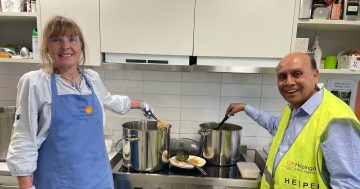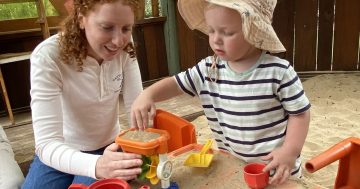
Photo: Supplied by Broad Agenda.
Canberra has a reputation for being a great place to live, particularly for families. Our city is known for high average income and education levels, great schools, employment opportunities, and established suburbs where homes often have no front fences because we want to show how welcoming we are.
But averages can hide what’s happening at the very top and bottom of the range. According to 2016 Census data, there were 37,213 people in Canberra living in a household with an equivalised weekly income of $500 per week or less. Of those, there were 7,867 children. That’s 11 per cent of Canberra’s population.
Improving the household income by getting a better job may not be easy for 5 per cent of Canberrans, as they finished their education before graduating Year 10. In a city where the majority of employment opportunities are in office environments, that can be a real disadvantage.
These figures were published in a report for Anti-Poverty Week in 2017, using data compiled by the National Centre for Social and Economic Modelling (NATSEM).
In addition, Anglicare’s 2018 Rental Affordability Snapshot shows that there was not a single property on the private rental market in Canberra for a single parent with children, or a single person who is unemployed or on a disability pension.
What the 2017 report didn’t show was the gendered levels of disadvantage in Canberra. Drive through Canberra’s suburbs, and what you won’t see is there are more women over the age of 15 on low incomes than men. That there are two and a half times as many single mothers in low income households as single fathers. Or that 5.8 per cent of women in Canberra finished school before completing Year 10, compared to 4.8 per cent of men.
In a report published on Monday 4 June by Women’s Centre for Health Matters, NATSEM provided a gendered breakdown of the levels of disadvantage by suburb.
What the data shows is that of the 100 Canberra suburbs for which data was available, 25 suburbs have high proportions of women on low income, but only 16 suburbs have a high proportion of men on low incomes.
There are 25 suburbs with a high proportion of women in sole parent households on low income, as well as children in sole parent households on low income. But there are only 2 suburbs where there are high proportions of men, as well as children, in sole parent households on low income.
There are a staggering 26 suburbs in Canberra where there are high proportions of women in sole parent households on low income, and high proportions of women who finished school without completing Year 10.
Multiple disadvantage: suburbs with a high proportion of women who are sole parents on low income AND women with less than Year 10 education.
But only 1 suburb with high proportions of men in sole parent households on low income, and high proportions of men who left school without completing Year 10.
Multiple disadvantage: suburbs with high proportion of men who are sole parents on low income AND men with less than Year 10 education
What this means is that, despite the beautiful streets full of houses without front fences, there are thousands of Canberrans whose disadvantage in terms of low income, sole parent responsibilities, or a low level of education, are hidden. What’s more, there are more suburbs with high proportions of women, many of them with children, experiencing disadvantage than men. It’s the higher incomes of a minority at the top end of the income scale that can mask what’s happening for the 11 per cent of Canberrans who aren’t even close to earning an average income.
Matt Grudnoff, a senior economist at The Australia Institute, spoke at the launch of the report about how averages can distort the picture.
“Imagine that you’re in the kitchen and your feet are in the oven, and your head is in the freezer. On average across your whole body, you’d be a nice warm temperature. But your feet are burning and your head is freezing,” Grudnoff explained.
Looking at suburbs with high levels of disadvantage, many of them are not within walking distance of a town centre. This can reduce access to employment, higher education, and services such as health care.
Most of these suburbs were also established prior to 1986, which means the housing available for rent here may be older and less energy efficient, and more likely to need repair as buildings age.
For the high proportions of single mothers with children on low income in these suburbs, and for women whose employment opportunities are restrained by their educational qualifications, these are the suburbs where they are more likely to be able to find an affordable home in the private rental market, or where there is existing public housing stock (for which there is a wait of more than 274 days).
Speaking at the launch of the report, 50/50 by 2030 Foundation Director Virginia Haussegger talked about the importance of having access to data that helps us understand where women are experiencing disadvantage, and what those disadvantages are, when policy decisions are being made.
Also speaking at the launch, Susan Helyar, Director of ACTCOSS, said that it’s important to be aware of the number of people on very low incomes in the ACT. She talked about the importance of work such as this in understanding how we can be more egalitarian and make Canberra more liveable for women. She also said that we need more of a focus on community and social infrastructure to enable social cohesion.
ACT Woman of the Year for 2018, Ashleigh Streeter-Jones, encouraged attendees at the launch to let their government representatives know what their priorities are, so that they can make better decisions about funding for programs that the community feels are most important. She commented on our accessible local politicians and that we have a majority female members in our Legislative Assembly, so we have an opportunity to make change.
The idea of having an impact statement for inequality and gender on every policy put forward by government was raised by Matt Grudnoff. Having an impact statement would enable the community to understand whether a policy would increase inequality, or reduce it, and make a decision as to whether the benefits of the policy outweigh the other impacts it may have.
Death, disability, divorce, and domestic violence can happen to anyone. These women did not choose to experience disadvantage. Now that they are experiencing it, their choices in other areas of their life are limited by what they can afford and what is in their local area (eg access to housing, employment, education, and health services). As a community, we have choices in what support we offer, and how and where we deliver it.
The map below shows the levels of each of the disadvantages measured across each of the 100 suburbs for which data was published from the 2016 Census.
- A very high proportion of women or men (including girls or boys) in low income households would be 14 per cent or higher.
- A very high proportion of women or men who are sole parents in low income households would be 2.5 per cent or higher.
- A very high proportion of girls or boys living in sole parent families on low income would be 8 per cent or higher.
- A very high proportion of women aged 15 years or more who have not completed Year 10 and are not still studying would be 7 per cent or higher.
The full report is available online from Women’s Centre for Health Matters.



















